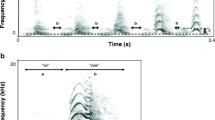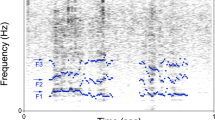Abstract
Copulation calls are a relatively common feature of female primate behavior thought to function in the advertisement of female receptivity and subsequent incitation of male–male competition. To date, the majority of work on copulation calling behavior has focused on various monkey species, with little empirical evidence from the great apes. Previous research on wild chimpanzees (Pan troglodytes schweinfurthii) has suggested that estrous females produce copulation calls to avoid monopolization by single males and to minimize competition from other females. We here extended these findings by investigating to what degree these social demands were reflected in the calls’ acoustic structure. We recorded and acoustically analyzed 71 copulation call bouts from 6 adult female chimpanzees in the Budongo Forest, Uganda. We did not find any acoustic differences in calls given by females in fertile and nonfertile periods, as assessed by their hormonal profiles. However, the calls’ acoustic structure did reliably encode identity cues of the calling female. We propose that, in chimpanzees, the use and morphology of copulation calls have jointly been shaped by the selective advantage of concealing fertility. Owing to the low visibility conditions associated with chimpanzees’ natural forest habitat and their dispersed social system, providing identity cues may be of particular biological relevance for these nonhuman primates.

Similar content being viewed by others
References
Allison, P. D. (1999). Multiple regression: A primer. Thousand Oaks: Pine Forge.
Bahr, N. I., Palme, R., Möhle, U., Hodges, J. K., & Heistermann, M. (2000). Comparative aspects of the metabolism and excretion of cortisol in three individual nonhuman primates. General and Comparative Endocrinology, 117, 427–438.
Bielert, C., & van der Walt, L. A. (1982). Male chacma baboon (Papio ursinus) sexual arousal; mediation by visual cues from female conspecifics. Psychoneuroendocrinology, 7, 31–48.
Boesch, C., & Boesch Achermann, H. (2000). The chimpanzees of the Tai Forest: Behavioral ecology and evolution. Oxford: Oxford University Press.
Cox, C. R., & LeBoeuf, B. J. (1977). Female incitation of male competition: a mechanism in sexual selection. American Naturalist, 111, 317–335.
Deschner, T., & Boesch, C. (2007). Can the patterns of sexual swelling cycles in female Taï chimpanzees be explained by the cost-of-sexual-attraction hypothesis? International Journal of Primatology, 28(2), 389–406.
Deschner, T., Heistermann, M., Hodges, K., & Boesch, C. (2003). Timing and probability of ovulation in relation to sex skin swelling in wild West African chimpanzees, Pan troglodytes verus. Animal Behaviour, 66, 551–560.
Deschner, T., Heistermann, M., Hodges, K., & Boesch, C. (2004). Female sexual swelling size, timing of ovulation and male behaviour in wild West African chimpanzees. Hormones and Behaviour, 45, 204–215.
De Waal, F. B. M. (1982). Chimpanzee politics: Power and sex among apes. London: Cape.
Dixson, A. F. (1998). Primate sexuality. Oxford: Oxford University Press.
Emery Thompson, M., Stumpf, R. M., & Pusey, A. E. (2008). Female reproductive strategies and competition in apes. International Journal of Primatology, 29, 815–821.
Furuichi, T. (1987). Sexual swelling, receptivity, and grouping of wild pygmy chimpanzee females at Wamba, Zaire. Primates, 23(3), 309–318.
Goodall, J. (1986). The chimpanzees of Gombe: Patterns of behaviour. Cambridge: Harvard University Press.
Hamilton, W. J. I., & Arrowood, P. C. (1978). Copulatory vocalizations of chacma baboons (Papio ursinus), gibbons (Hylobates hoolock), and humans. Science, 200, 1405–1409.
Henzi, S. P. (1996). Copulation calls and paternity in chacma baboons. Animal Behaviour, 51, 233–234.
Higham, J. P., MacLarnon, A., Ross, C., Heistermann, M., & Semple, S. (2008). Baboon sexual swellings: information content of size and color. Hormones and Behaviour, 53, 452–462.
Kahlenberg, S. M. (2006). Female-female competition and male sexual coercion in wild Kanyawara chimpanzees. Ph.D. thesis, Harvard University.
Kahlenberg, S. M., Emery Thompson, M., Muller, M. N., & Wrangham, R. W. (2008). Immigration costs for female chimpanzees and male protection as an immigrant counterstrategy to intrasexual aggression. Animal Behaviour, 76, 1497–1509.
Kahlenberg, S. M., Emery Thompson, M., & Wrangham, R. W. (2008). Female competition over core areas among Kanyawara chimpanzees, Kibale National Park, Uganda. International Journal of Primatology, 29, 931–947.
Muller, M., Emery-Thompson, M., & Wrangham, R. W. (2006). Male chimpanzees prefer mating with old females. Current Biology, 16, 2234–2238.
Mundry, R., & Sommer, C. (2007). Discriminant function analysis with non-independent data: consequences and an alternative. Animal Behaviour, 74, 965–976.
Murray, C. M., Wroblewski, E., & Pusey, A. E. (2007). New case of intragroup infanticide in the chimpanzees of Gombe National Park. International Journal of Primatology, 28, 23–37.
Nikitopoulos, E., Arnhem, E., van Hooff, J., & Sterck, E. (2004). Influence of female copulation calls on male sexual behavior in captive Macaca fascicularis. International Journal of Primatology, 25, 659–677.
O’Connell, S. M., & Cowlishaw, G. (1994). Infanticide avoidance, sperm competition and mate choice: the function of copulation calls in female baboons. Animal Behaviour, 48, 687–694.
Oda, R., & Masataka, N. (1995). Function of copulatory vocalizations in mate choice by female Japanese macaques (Macaca fuscata). Folia Primatologica, 64, 132–139.
Pfefferle, D., Brauch, K., Heistermann, M., Hodges, J. K., & Fischer, J. (2008). Female Barbary macaque (Macaca sylvanus) copulation calls do not reveal the fertile phase but influence mating outcome. Proceedings of the Royal Society of London Series B: Biological Sciences, 275, 571–578.
Pinheiro, J. C., & Bates, D. M. (2000). Mixed-effects models in S and S-PLUS. New York: Springer.
Poole, J. H., Payne, K. B., Langbauer, W., Jr., & Moss, C. J. (1988). The social contexts of some very low frequency calls of African elephants. Behavioural Ecology and Sociobiology, 22, 385–392.
Pradhan, G. R., & van Schaik, C. (2008). Infanticide-driven intersexual conflict over matings in primates and its effects on social organisation. Behaviour, 145, 251–275.
Pradhan, G., Engelhard, A., van Schaik, C. P., & Maestripieri, D. (2006). The evolution of female copulation calls in primates: a review and a new model. Behavioural Ecology and Sociobiology, 59, 333–343.
Pusey, A. E., Williams, J., & Goodall, J. (1997). The influence of dominance rank on the reproductive success of female chimpanzees. Science, 277, 828–831.
Reynolds, V. (2005). The chimpanzees of the Budongo forest – Ecology, behaviour, and conservation. Oxford: Oxford University Press.
Semple, S. (1998). The function of Barbary macaque copulation calls. Proceedings of the Royal Society of London Series B: Biological Sciences, 265, 287–291.
Semple, S. (2001). Individuality and male discrimination of female copulation calls in the yellow baboon. Animal Behaviour, 61, 1023–1028.
Semple, S., McComb, K., Alberts, S., & Altmann, J. (2002). Informational content of female copulation calls in yellow baboons. American Journal of Primatology, 56, 43–56.
Slocombe, K. E., & Zuberbühler, K. (2007). Chimpanzees modify recruitment screams as a function of audience composition. Proceedings of the National Academy of Sciences of the USA, 104(43), 17228–17233.
Tibbetts, E. A., & Dale, J. (2007). Individual recognition: it is good to be different. Trends in Ecology & Evolution, 22, 529–537.
Townsend, S. W., Slocombe, K. E., Emery-Thompson, M., & Zuberbühler, K. (2007). Female-led infanticide in wild chimpanzees. Current Biology, 17(10), 355–356.
Townsend, S. W., Deschner, T., & Zuberbühler, K. (2008). Female chimpanzees use copulation calls flexibly to prevent social competition. PloS One, 3(6), e2431.
van Schaik, C. P. (2000). Infanticide by male primates: The sexual selection hypothesis revisited. In C. P. van Schaik & C. H. Janson (Eds.), Infanticide by males and its implications (pp. 27–60). Cambridge: Cambridge University Press.
Acknowledgments
We thank the Ugandan Wildlife Authority and the President’s Office of the Uganda National Council for Science and Technology for permission to work in the forest. We thank Vernon Reynolds and Fred Babweteera for their support; Eric Bowman and Roger Mundry for their statistical advice; Vera Schmeling for assistance with the hormone analysis; Joanna Setchell, Manuela Cadilek, and 2 anonymous reviewers for their comments on the manuscript; and Monday M. Gideon for his invaluable help and company in the forest. This study was funded by the BBSRC, the Leverhulme Trust, and the Max Planck Society. We thank the Royal Zoological Society of Scotland for providing core funding to the Budongo Conservation Field Station. We dedicate this study to the memory of our friend and colleague, the late Odong-too Richard.
Author information
Authors and Affiliations
Corresponding author
Rights and permissions
About this article
Cite this article
Townsend, S.W., Deschner, T. & Zuberbühler, K. Copulation Calls in Female Chimpanzees (Pan troglodytes schweinfurthii) Convey Identity but Do Not Accurately Reflect Fertility. Int J Primatol 32, 914–923 (2011). https://doi.org/10.1007/s10764-011-9510-2
Received:
Accepted:
Published:
Issue Date:
DOI: https://doi.org/10.1007/s10764-011-9510-2




